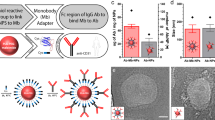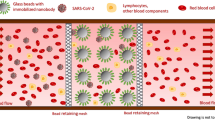Abstract
Anti-A/B antibody removal from blood reduces the hyperacute rejection risk following ABO-incompatible transplantation. We are developing an integrated bead and fiber module (BSAF) that selectively removes anti-A from blood. In BSAF blood flows through the inner lumen of microfiltration fibers. Starling flow carries plasma from the inner fiber lumen to the beads in the shell compartment where antibodies bind to covalently attached antigens on the beads. In this study, we developed a mathematical model to guide the choice of key design and operational parameters for a clinical BSAF device. The model demonstrated that for a given flow rate and reservoir volume, antibody removal rate was dependent on the magnitude of a lumped parameter, k L m B/Q s, that characterizes the ratio of antibody uptake rate by the beads to the Starling flow rate in the device. The highest antibody removal rate was predicted for the perfusion limited regime, when k L m B/Q s → 10; Once this maximum limit was obtained, any further increase in the antibody removal rate was only possible by increasing the flow rate. Key model predictions were validated in a series of experiments. The model was then used to conceptually design a BSAF capable of a clinically relevant rate of anti-A removal.







Similar content being viewed by others
References
Alexandre, G. P., et al. Human ABO-incompatible living donor renal homografts. Neth. J. Med. 28:231–234, 1985.
Alikhani, A., et al. High molecular weight blood group A trisaccharide-polyacrylamide glycoconjugates as synthetic blood group A antigens for anti-A antibody removal devices. J. Biomed. Mater. Res. B 91:845–854, 2009.
Apelblat, A., et al. A mathematical analysis of capillary–tissue fluid exchange. Biorheology 11:1–49, 1974.
Bannett, A. D., et al. Experiences with known ABO-mismatched renal transplants. Transplant. Proc. 19:4543–4546, 1987.
Bird, R. B., et al. Transport Phenomena. New York: Wiley, 2002.
Boberg, K. M., et al. ABO-incompatible deceased donor liver transplantation with the use of antigen-specific immunoadsorption and anti-CD20 monoclonal antibody. Clin. Transplant. 20:265–268, 2006.
Bovin, N. Polyacrylamide-based glycoconjugates as tools in glycobiology. Glycoconj. J. 15:431–446, 1998.
Bovin, N. V., et al. Synthesis of polymeric neoglycoconjugates based on n-substituted polyacrylamides. Glycoconj. J. 10:142–151, 1993.
Donauer, J., et al. ABO-incompatible kidney transplantation using antigen-specific immunoadsorption and rituximab: a single center experience. Xenotransplantation 13:108–110, 2006.
Ettenauer, M., et al. Magnetic fluorescent microparticles as markers for particle transfer in extracorporeal blood purification. Biomacromolecules 12:3693–3696, 2007.
Fukunaga, K., et al. Preliminary evaluation study of a prototype hollow fiber membrane for the continuous membrane autotransfusion system. Ther. Apher. 3:63–68, 1999.
Furst, D., et al. Immunoadsorption for the treatment of rheumatoid arthritis: final results of a randomized trial. Ther. Apher. 4:363–373, 2000.
Gautam, S., et al. Monoclonal anti-A antibody removal by synthetic A antigen immobilized on specific antibody filters. Biotechnol. Bioeng. 99:876–883, 2008.
Goldsby, R. A., et al. Immunology. New York: W.H. Freeman and Company, 2003.
Hanto, D. W., et al. ABO-incompatible liver transplantation with no immunological graft losses using total plasma exchange, splenectomy, and quadruple immunosuppression: evidence for accommodation. Liver Transpl. 9:22–30, 2003.
Heidrun, U., et al. Improved treatment of sudden hearing loss by specific fibrinogen aphaeresis. J. Clin. Apher. 19:71–78, 2004.
Hermanson, G. T., et al. Immobilized Affinity Ligand Techniques. San Diego: Academic Press Inc., 1992.
Hout, M. S., and W. J. Federspiel. Mathematical and experimental analyses of antibody transport in hollow-fiber-based specific antibody filters. Biotechnol. Prog. 19:1553–1561, 2003.
Hout, M. S., et al. Specific removal of anti-A and anti-B antibodies by using modified dialysis filters. ASAIO J. 46:702–706, 2000.
Korchagina, E. Y., and N. V. Bovin. Synthesis of spacered trisaccharides with blood group A and B specificities and fragments and structural analogues of them. Sov. J. Bioorg. Chem. 18:153–165, 1992.
Mor, E., et al. Successful use of an enhanced immunosuppressive protocol with plasmapheresis for ABO-incompatible mismatched grafts in liver transplant recipients. Transplantation 59:986–990, 1995.
Norden, G., et al. ABO-incompatible live donor renal transplantation using blood group A/B carbohydrate antigen immunoadsorption and anti-CD20 antibody treatment. Xenotransplantation 13:148–153, 2006.
Rieben, R., et al. In vitro evaluation of the efficacy and biocompatibility of new, synthetic ABO immunoabsorbents. Transplantation 60:425–430, 1995.
Rydberg, L. ABO-incompatibility in solid organ transplantation. Transfus. Med. 11:325–342, 2001.
Rydberg, L., et al. In vitro assessment of a new ABO immunosorbent with synthetic carbohydrates attached to sepharose. Transpl. Int. 17:666–672, 2005.
Skogsberg, U., et al. Adult ABO-incompatible liver transplantation, using A and B donors. Xenotransplantation 13:154–159, 2006.
Solovan, J. C., et al. Synthetic blood group antigens for anti-A removal device and their interaction with monoclonal anti-A IgM. Transpl. Immunol. 16:245–249, 2006.
Starling, E. H. On the absorption of fluid from the connective tissue space. J. Physiol. 19:312–326, 1896.
Tanabe, K., et al. Long-term results of ABO-incompatible living kidney transplantation: a single-center experience. Transplantation 65:224–228, 1998.
Thomas, B., et al. State of the art of low-density lipoprotein apheresis in the year 2003. Ther. Apher. Dial. 8:76–79, 2004.
Troisi, R., et al. ABO-mismatch adult living donor liver transplantation using antigen-specific immunoadsorption and quadruple immunosuppression without splenectomy. Liver Transpl. 12:1412–1417, 2006.
Tydén, G., et al. The European experience. Transplantation 84(12 Suppl):S2–S3, 2007.
Unger, J. K., et al. Maximal flow rates and sieving coefficients in different plasmafilters: effects of increased membrane surfaces and effective length under standardized in vitro conditions. J. Clin. Apher. 17:190–198, 2002.
Watkins, W. M. The ABO blood group system: historical background. Transfus. Med. 11:243–265, 2001.
Weber, C., and D. Falkenhagen. Extracorporeal removal of proinflammatory cytokines by specific absorption onto microspheres. ASAIO J. 42:M908–M911, 1996.
Weber, V., et al. Efficient adsorption of tumor necrosis factor with an in vitro set-up of the microspheres-based detoxification system. Blood Purif. 25:169–174, 2007.
Acknowledgments
The work presented in this publication was made possible by Grant Number HL69956-01 from the National Institutes of Health (NIH), National Heart, Lung, and Blood Institute and its contents are solely the responsibility of the authors and do not necessarily represent the official views of the National Heart, Lung, and Blood Institute or NIH. We would like to recognize the McGowan Institute for Regenerative Medicine for support on this study.
Author information
Authors and Affiliations
Corresponding author
Additional information
Associate Editor Bahman Anvari oversaw the review of this article.
Rights and permissions
About this article
Cite this article
Alikhani, A., Federspiel, W.J. Theoretical and Experimental Analysis of Anti-A Antibody Capture in Novel Integrated Bead and Hollow Fiber Modules. Ann Biomed Eng 39, 953–963 (2011). https://doi.org/10.1007/s10439-010-0233-x
Received:
Accepted:
Published:
Issue Date:
DOI: https://doi.org/10.1007/s10439-010-0233-x




